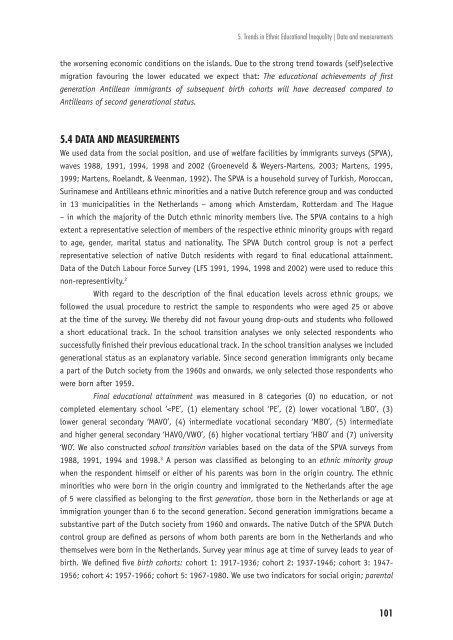Ethnic Hostility among Ethnic Majority and Minority Groups
Ethnic Hostility among Ethnic Majority and Minority Groups
Ethnic Hostility among Ethnic Majority and Minority Groups
You also want an ePaper? Increase the reach of your titles
YUMPU automatically turns print PDFs into web optimized ePapers that Google loves.
the worsening economic conditions on the isl<strong>and</strong>s. Due to the strong trend towards (self)selective<br />
migration favouring the lower educated we expect that: The educational achievements of fi rst<br />
generation Antillean immigrants of subsequent birth cohorts will have decreased compared to<br />
Antilleans of second generational status.<br />
5.4 DATA AND MEASUREMENTS<br />
We used data from the social position, <strong>and</strong> use of welfare facilities by immigrants surveys (SPVA),<br />
waves 1988, 1991, 1994, 1998 <strong>and</strong> 2002 (Groeneveld & Weyers-Martens, 2003; Martens, 1995,<br />
1999; Martens, Roel<strong>and</strong>t, & Veenman, 1992). The SPVA is a household survey of Turkish, Moroccan,<br />
Surinamese <strong>and</strong> Antilleans ethnic minorities <strong>and</strong> a native Dutch reference group <strong>and</strong> was conducted<br />
in 13 municipalities in the Netherl<strong>and</strong>s – <strong>among</strong> which Amsterdam, Rotterdam <strong>and</strong> The Hague<br />
– in which the majority of the Dutch ethnic minority members live. The SPVA contains to a high<br />
extent a representative selection of members of the respective ethnic minority groups with regard<br />
to age, gender, marital status <strong>and</strong> nationality. The SPVA Dutch control group is not a perfect<br />
representative selection of native Dutch residents with regard to fi nal educational attainment.<br />
Data of the Dutch Labour Force Survey (LFS 1991, 1994, 1998 <strong>and</strong> 2002) were used to reduce this<br />
non-representivity. 2<br />
5. Trends in <strong>Ethnic</strong> Educational Inequality | Data <strong>and</strong> measurements<br />
With regard to the description of the fi nal education levels across ethnic groups, we<br />
followed the usual procedure to restrict the sample to respondents who were aged 25 or above<br />
at the time of the survey. We thereby did not favour young drop-outs <strong>and</strong> students who followed<br />
a short educational track. In the school transition analyses we only selected respondents who<br />
successfully fi nished their previous educational track. In the school transition analyses we included<br />
generational status as an explanatory variable. Since second generation immigrants only became<br />
a part of the Dutch society from the 1960s <strong>and</strong> onwards, we only selected those respondents who<br />
were born after 1959.<br />
Final educational attainment was measured in 8 categories (0) no education, or not<br />
completed elementary school ‘












